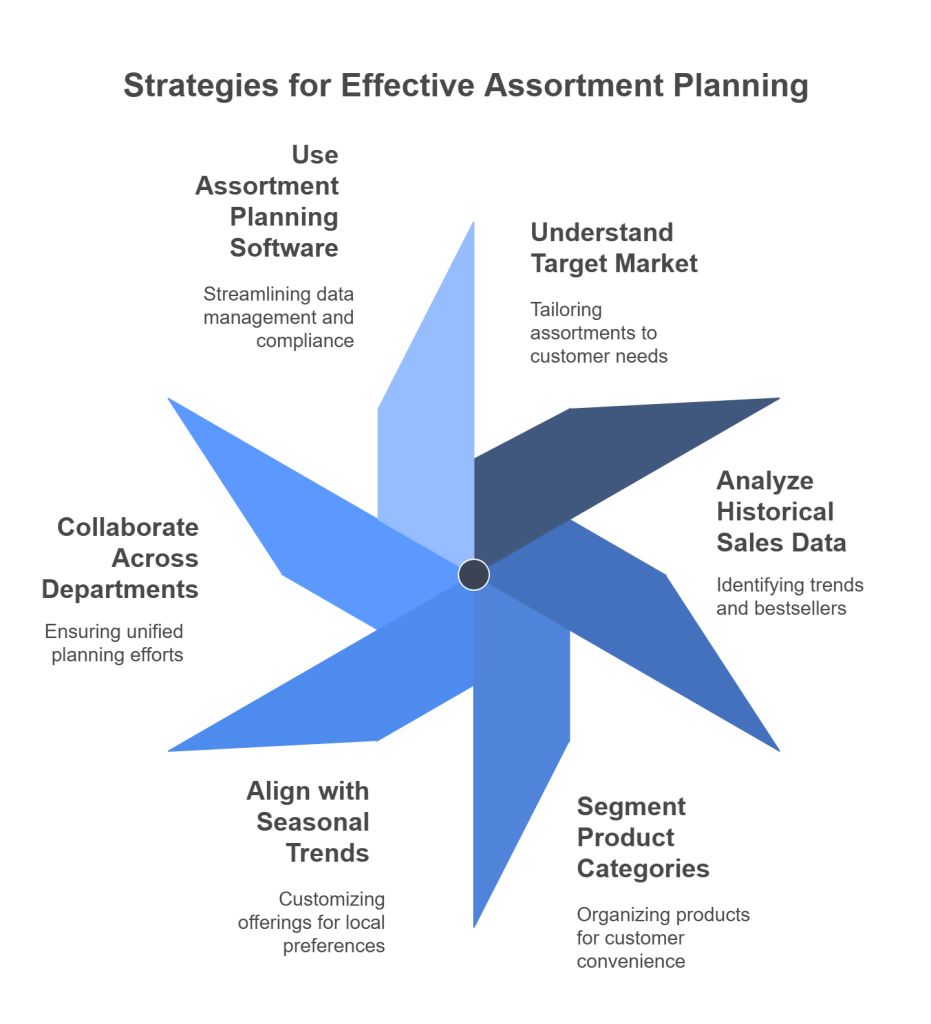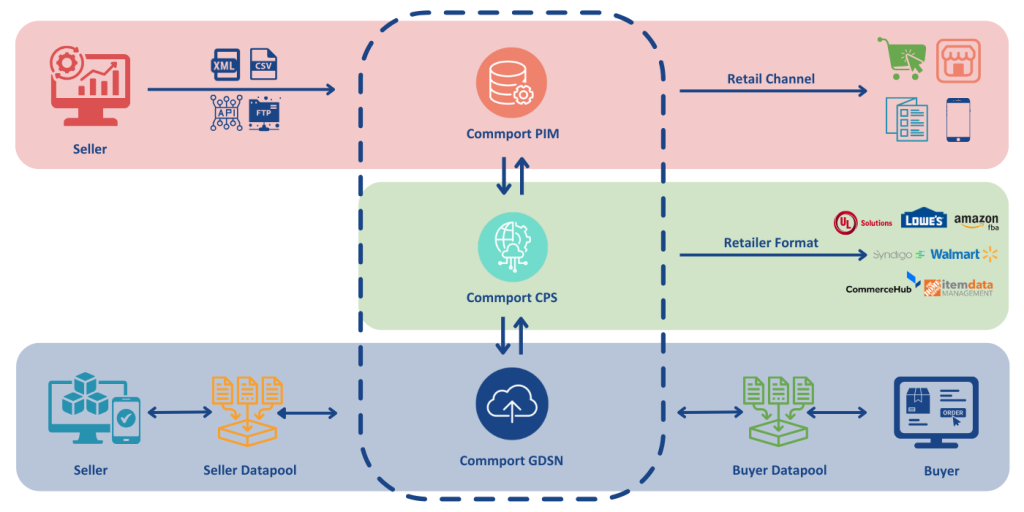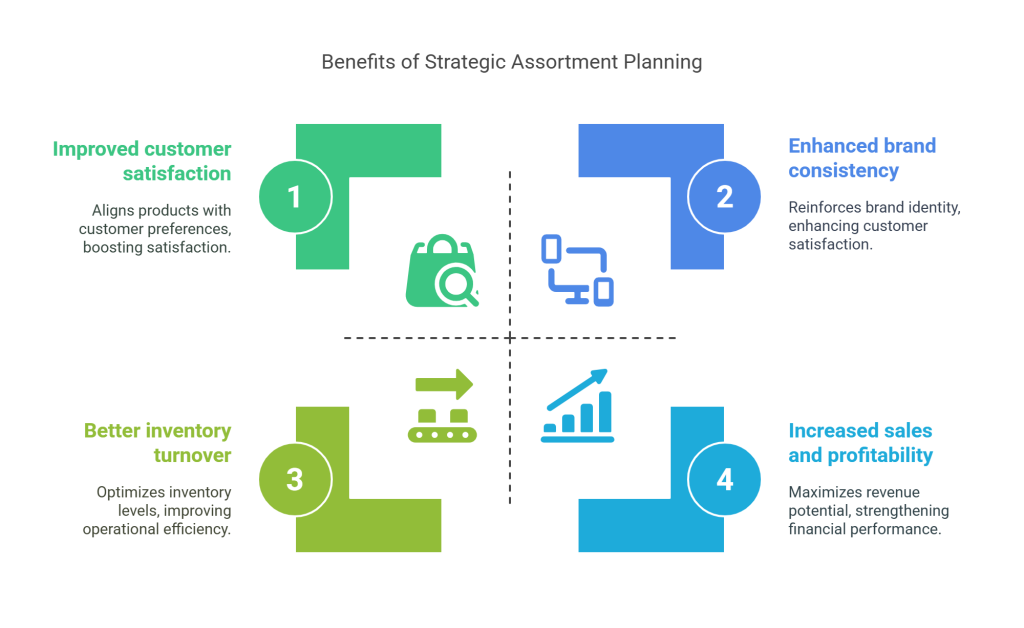Introduction
In today’s retail environment, managing product assortments across multiple channels and geographies has become increasingly complex. Assortment planning plays a critical role in delivering the right products at the right prices to the right places, especially as consumer shopping habits continue to evolve.
Yet despite this growing complexity, many retailers still rely on hundreds of spreadsheets and manual processes for their product information management. This outdated approach often leads to frustrated customers, decreased product availability, and missed opportunities for growth. Effective retail assortment planning isn’t just about having products on shelves — it’s about strategically curating what merchandise to stock, when to stock it, and how to display it to maximize sales and customer satisfaction.
In this guide, we’ll explore assortment planning, why it’s different from general merchandise planning, and how you can implement best practices to stay competitive. We’ll also look at practical assortment planning examples and recommend affordable and scalable Commport Datapool solutions such as GDSN (Global Data Synchronization Network) and PIM (Product Information Management) that can help you move beyond spreadsheets to a more robust assortment management approach.
What is Assortment Planning?
The retail industry relies on a systematic approach to product selection that goes beyond simply stocking shelves. Assortment planning sits at the heart of this process, acting as the cornerstone of retail strategy.
Assortment Planning Definition and Meaning
Assortment planning is the strategic process of selecting which products to sell during specific periods and determining how to distribute those products across different locations and sales channels.
Essentially, it’s about offering the right styles, in the right sizes and colors, through the right channels to maximize profits. Unlike intuitive buying practices that small shops might use, larger retailers implement comprehensive operations to monitor key performance indicators and make data-driven decisions.
This tactical process responds to local market conditions and sudden shifts in demand, making it highly adaptable to changing consumer preferences. For instance, a clothing brand might sell bathing suits during summer but shift to fleece jackets during winter, or stock cold-weather items primarily in stores located in snowy regions.
Why it Matters in Modern Retail
Assortment planning holds significant importance because it determines the precise product mix for each store – assortments that must fit within available space, leverage store strengths, cater to customer preferences, and drive sales. A study found that 93% of retailers struggle with planning merchandise assortment, highlighting the critical nature of this function.
Furthermore, effective assortment planning delivers several key benefits:
- Increased sales, improved cash flow, and greater profitability
- Enhanced inventory management, preventing both overcrowded and understocked shelves
- Better customer experience as shoppers more consistently find what they want
- Reduced likelihood of markdowns and excess inventory
The key premise of proper assortment planning is basing purchases on data rather than estimates. This data-driven approach enables retailers to catch potential mistakes before they impact the business.
Difference Between Merchandise and Assortment Planning
Though often used interchangeably, merchandise and assortment planning serve distinct functions. Merchandise planning works at a higher level, creating budgets for seasonal merchandise without drilling down into specific products. It establishes financial constraints and focuses on the “how much” and “when” aspects of inventory decisions.
Conversely, assortment planning dives deeper into specifics. After merchandise planning sets the financial framework, assortment planning determines exactly which products to offer – the styles, colors, and sizes that will appeal to target customers. As one expert noted, “Retailers don’t sell categories; they sell products and styles”. This is where competitive advantage often emerges, through skillful selection of the product mix that resonates with consumers.
How to Build an Effective Assortment Planning Strategy

Creating an effective assortment plan requires a methodical approach that balances data, customer insights, and business goals. By following these six key strategies, retailers can develop assortment plans that drive sales while satisfying customer demands.
- Understand your target market
Customer segmentation forms the foundation of successful assortment planning. Breaking down your customer base into segments based on buying behavior, preferences, demographics, and psychographics allows you to tailor your assortment specifically to each group’s needs. Retailers that implement feedback mechanisms such as surveys, reviews, and social media listening gain invaluable insights into customer satisfaction and emerging demand trends. This customer-centric approach ensures your product mix resonates with shoppers, ultimately driving loyalty and repeat purchases.
- Analyze historical sales data
Historical sales data reveals crucial patterns about which products perform well and which underperform. This analysis should examine seasonal trends, product life cycles, and SKU performance over time. By leveraging this data, retailers can identify bestsellers that should remain in the assortment while spotting underperforming items that might need elimination. Furthermore, this data serves as the foundation for accurate demand forecasting, helping retailers adjust their assortment planning accordingly to anticipate future customer needs.
- Segment your product categories
Most businesses group their products based on hierarchies that mirror customer decision-making paths. For instance, a mobile phone retailer might organize devices by budget ranges, brands, and features. This logical organization simplifies assortment planning and aligns with how customers naturally shop. Additionally, store clustering—grouping similar stores based on size and sales volume—enables retailers to design common plans for each cluster, thereby reducing duplicate work and saving considerable planning time.
- Align with seasonal and regional trends
Customizing product offerings to match local preferences creates more relevant assortments that drive sales. Businesses offering seasonal products should plan their assortments around festivals, economic conditions, weather patterns, holidays, and special events like weddings. For example, a beach-adjacent store would logically stock fewer sweaters during summer months, whereas a fashion retailer would balance traditional prints (which maintain consistent demand) with trendier seasonal styles.
- Collaborate across departments
Successful assortment planning requires input from multiple departments. Cross-functional teams comprising buying, merchandising, marketing, sales, supply chain, inventory management, and store operations ensure all perspectives are considered. Without leadership backing and proper tools, these collaborative efforts often fail. However, when properly aligned, cross-departmental collaboration breaks down silos, streamlines processes, and creates a unified approach to assortment planning that better serves customer needs.
- Use assortment planning software
Modern retailers increasingly depend on robust GDSN (Global Data Synchronization Network) and PIM (Product Information Management) solutions to ensure accurate, consistent, and real-time product data across all sales and supply chain channels. These systems streamline the exchange of standardized product information between trading partners, enhance data governance, and support compliance with global retail requirements. Leading solutions help retailers and suppliers synchronize attributes like pricing, descriptions, images, and specifications—improving product visibility, accelerating time-to-market, and reducing costly errors. As a result, GDSN and PIM platforms play a critical role in improving operational efficiency, customer experience, and inventory accuracy.
GDSN + PIM: A Powerful Duo for Assortment Optimization

GDSN Datapool
GDSN ensures that assortment planners work with accurate, validated, and real-time product data by:
- Enabling seamless data exchange with suppliers and partners
- Ensuring GS1 compliance for global product identifiers (e.g., GTINs, GLNs)
- Providing real-time updates when product specifications change
- Reducing data entry errors and delays
This allows teams to quickly adapt assortments to changing consumer needs, regulatory requirements, or market trends
PIM Solution
A PIM system empowers retailers and manufacturers by:
- Centralizing product data from multiple sources
- Enabling localized assortments by tailoring product information for regional preferences
- Streamlining product launches with faster time-to-market
- Enhancing product storytelling through rich media and contextual content
With PIM, companies can build customized assortments for different e-commerce platforms, physical stores, or customer segments.
Key Benefits of a Strong Assortment Plan

A well-executed assortment plan delivers tangible benefits that extend far beyond merely having products on shelves. As retailers face mounting pressure to meet consumer expectations, strategic assortment planning becomes increasingly vital to operational success.
- Improved customer satisfaction
At its core, assortment planning is about understanding and fulfilling customer preferences. By aligning products with what shoppers want, retailers create shopping experiences that foster loyalty and encourage repeat business. This customer-centric approach ensures products that shoppers desire are consistently available, significantly enhancing their overall satisfaction.
Additionally, when customers can reliably find what they need, they develop stronger connections with the brand. A thoughtfully curated assortment makes shopping effortless, customers spend less time searching and more time purchasing, ultimately leading to improved customer retention rates.
2. Better inventory turnover
Effective assortment planning dramatically improves how inventory moves through the supply chain. By optimizing inventory levels, retailers reduce both stockouts and overstocks, creating a healthier inventory turnover rate. This balanced approach keeps cash flowing rather than being tied up in excess merchandise.
Notably, according to retail analysts IHL, retailers worldwide lose approximately $1 trillion in revenue due to out-of-stock situations. Through proper assortment planning, businesses can prevent these losses while simultaneously reducing carrying costs for slow-moving inventory.
3. Increased sales and profitability
The financial impact of strategic assortment planning is substantial. When executed correctly, it directly increases sales, improves cash flow, and enhances overall profitability. This occurs because optimized assortments maximize the revenue potential of available inventory.
Furthermore, retailers experience improved sell-through rates and fewer markdowns when their product mix accurately reflects consumer demand. Instead of slashing prices to move stagnant inventory, they sell more merchandise at full price, preserving profit margins and strengthening financial performance.
4. Enhanced brand consistency
The assortment a retailer offers fundamentally reflects their brand identity. A carefully planned product mix reinforces the brand’s image and helps distinguish it from competitors. This consistency builds customer recognition and trust across all touchpoints.
Moreover, a curated assortment creates a distinct shopping environment that resonates with target customers. This distinctive identity becomes increasingly important as markets grow more competitive. Through consistent assortment planning, retailers establish a clear brand position that customers can easily recognize and connect with across multiple channels.
Conclusion
Assortment planning undoubtedly stands as a cornerstone of retail success in today’s ever-evolving marketplace. Throughout this guide, we’ve explored how strategic product selection directly impacts customer satisfaction, inventory management, and ultimately, your bottom line. The difference between merely stocking shelves and thoughtfully curating merchandise that resonates with your target audience cannot be overstated.
Data-driven decision making, rather than intuition alone, clearly provides the foundation for effective assortment planning. As we’ve seen from real-world examples, retailers who master this process gain significant competitive advantages, regardless of their specific market segment. Fashion retailers adjust to seasonal trends, grocery chains balance diverse customer preferences, and businesses across industries benefit from the digital transformation of their planning processes.
The six-step strategy outlined previously offers a practical roadmap for implementation. Initially, understanding your target market creates the foundation. Subsequently, analyzing historical data reveals critical patterns, while proper product segmentation mimics how customers shop. Additionally, aligning with seasonal and regional trends ensures relevance, and cross-departmental collaboration breaks down organizational silos.
Finally, embracing specialized software represents perhaps the most transformative step retailers can take. Commport Datapool Solutions can help you with assortment planning by providing the technological infrastructure needed to analyze customer data, optimize your product mix, and stay competitive in 2025 and beyond.
The retail landscape will certainly continue evolving, but the fundamental principles of assortment planning remain constant. Retailers who commit to offering the right products, at the right time, in the right places will thrive despite market challenges. Therefore, consider assortment planning not as an optional task but as an essential strategic function that directly connects your merchandise decisions to customer satisfaction and business growth.
Commport Datapool Solutions
Download: GDSN Buyers Guide
Empower your business with global data synchronization; download our GDSN Buyer's Guide today and take the first step towards streamlined, accurate, and compliant product data management.
Frequently Asked Questions
Assortment planning is a strategic process where retailers select and organize products to offer during specific time periods across various locations and sales channels. It involves analyzing data to determine the right mix of styles, sizes, and colors that will maximize profits and meet customer demands.
Effective assortment planning leads to improved customer satisfaction, better inventory turnover, increased sales and profitability, and enhanced brand consistency. It helps retailers offer products that resonate with their target audience while optimizing inventory levels and reducing the likelihood of markdowns.
The main steps include understanding your target market, analyzing historical sales data, segmenting product categories, aligning with seasonal and regional trends, collaborating across departments, and utilizing assortment planning software. This approach ensures a data-driven and customer-centric product selection process.
While merchandise planning focuses on creating budgets for seasonal merchandise at a higher level, assortment planning delves into the specifics of which products to offer. Assortment planning determines the exact styles, colors, and sizes that will appeal to target customers within the financial framework set by merchandise planning.
Assortment planning is complex due to the need to balance multiple factors, including consumer preferences, supply-chain constraints, and external market conditions. Retailers must make trade-offs while considering their target audience, inventory limitations, economic factors, and competitive strategies, making it a multifaceted decision-making process.





